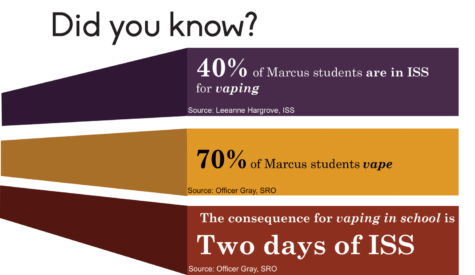While teen smoking is at a record low in 24 years, e-cigarette use has risen dramatically in popularity among high schoolers, according to the Center for Disease Control. As stated by the student resource officers, vaping is one of the most common issues they deal with.
SRO Joe Gray believes that as many as 70 to 75 percent of students on campus vape. ISS teacher Leeanne Hargrove estimates 40 percent of students in ISS are there for vaping in school, which she said is “a lot more from previous years.”
“Eighty percent of the time I walk into the bathroom, there’s some sort of vape [smoke/scent],” junior David Mowles said.
Senior Sam West doesn’t have a problem with students vaping off campus, as along as they know what they’re getting themselves into. He considers vaping in the restroom to be “a little bit disrespectful” to other students and the campus.
“It’s essentially like the kids in the 60s who’d smoke in the restroom. It’s just a different form,” West said. “Kids are always going to do that, nothing’s going to stop them. It’s just that rebellious angst that they’re trying to get out.”
Gray says that while vaping at school is common amongst students, students bringing alcohol to school and showing up intoxicated hasn’t given them the time to focus on vaping.
Currently, to stop students from vaping at school, the SROs have to catch them in the act and confiscate their vape.
“A lot of these kids have $100-$200 mods that they can’t afford to keep buying,” Gray said.
The consequence for vaping in school is two days in ISS for the first offense, and increases after each offense. For repeated offenses at school, the SROs can send students to court, which has happened in the past though Gray says it’s uncommon. The SROs test the vape for THC alongside other drugs, and if drugs are found the student could be sent to jail. So far that hasn’t happened. Vaping devices may be picked up at the front office by the student’s parents if they’re taken.
Outside of school, students under 18 will be ticketed up to $250, and must attend community service or an E-Cigarette and Tobacco Awareness Program. They could also have their driver’s license suspended. In Flower Mound, vaping is subject to the same laws as smoking.

“Almost all the kids that are in [ISS] for vaping are underage,” Hargrove said. “So it’s a legal issue regardless of whether or not it’s a school policy.”
Alongside legal issues, vaping poses a health threat especially to young adults. Adolescents are more sensitive to the addictive effects of nicotine and it can interfere with development. Gray said that the SROs “know there’s athletes who [vape/smoke],” which can affect performance.
“Addiction — because nicotine is an addictive substance — alters the way your brain develops,” Gray said. “Because until you’re 25, your brain is still developing.”
On Aug. 8, 2016, the FDA announced they would regulate all vape, e-cigarettes and e-liquid — even those containing zero nicotine. This year, the deadline for regulation was extended to Aug. 8, 2022, and products under review by the FDA may still be sold. This allows retailers to sell e-cigarettes without FDA confirmation on the ingredients. Currently the only regulation on vaping is restricting the sale to minors.
A major health concern about vaping arose in 2015 when it was found that 90 percent of flavors of vape contain chemicals that cause “popcorn lung”, a permanent condition that causes coughing and shortness of breath. Without regulation by the FDA, there’s no way to determine whether or not these chemicals are still in vape.
“It’s like the gilded age in a sense, all the flashy mods, lights, tanks, but if you break it down to its core, it’s still a serious deal, just like smoking,” West said. “It’s only a different version with fewer health risks.”
E-cigarettes and vaping devices are still a relatively new product on the market — they were first sold in 2007. It took several decades before the dangers of cigarettes were discovered. Much about vaping still remains unknown.
“Just leave it alone. Wait until you’re older and if you want to make that decision, once you’re more equipped to do so, then do it then,” Gray said. “There’s no reason in starting to do something when you’re 15 or 16.”





